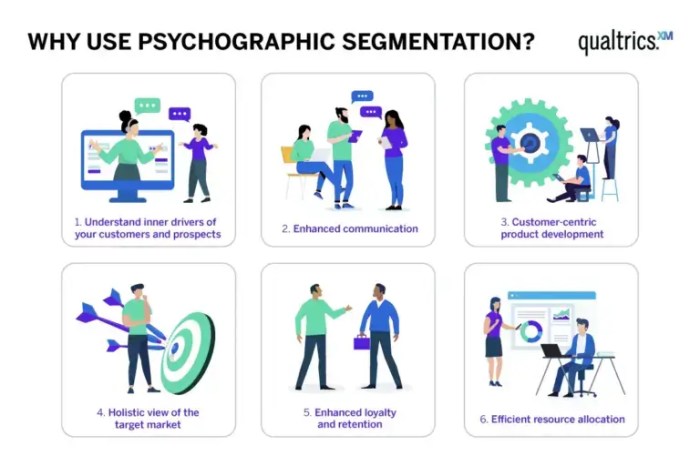Understanding Audience Psychographics sets the stage for unlocking powerful marketing strategies, diving deep into the minds of consumers to drive engagement and success. Get ready to explore the dynamic world of audience analysis like never before.
In today’s ever-evolving market, understanding the intricacies of audience psychographics is essential for businesses looking to connect with their target demographics on a deeper level.
Importance of Understanding Audience Psychographics

Understanding audience psychographics is crucial for effective marketing because it helps businesses tailor their messaging, products, and services to meet the specific needs and preferences of their target audience. By delving into the psychological characteristics, behaviors, and attitudes of consumers, businesses can create targeted marketing campaigns that resonate with their audience on a deeper level.
Benefits of Analyzing Audience Psychographics
Analyzing audience psychographics can provide businesses with valuable insights that can lead to increased customer engagement and loyalty. Here are some examples of how businesses can benefit from analyzing audience psychographics:
- Personalized Marketing: By understanding the values, interests, and motivations of their audience, businesses can create personalized marketing messages that speak directly to their target customers.
- Product Development: By analyzing psychographics, businesses can identify gaps in the market and develop products or services that align with the preferences of their target audience.
- Improved Customer Segmentation: Understanding audience psychographics allows businesses to segment their target market more effectively, ensuring that their marketing efforts reach the right people with the right message.
- Increased ROI: By tailoring their marketing strategies based on psychographic data, businesses can improve the return on investment of their marketing campaigns, ultimately leading to higher sales and revenue.
Definition of Audience Psychographics
Audience psychographics refer to the study of personality, values, interests, attitudes, lifestyles, and behaviors of a particular audience segment. Unlike demographics, which focus on quantifiable data such as age, gender, income, and location, psychographics delve deeper into the psychological aspects that drive consumer behavior.
Examples of Psychographic Factors
Psychographic factors are essential for marketers to understand the motivations and preferences of their target audience. Some common psychographic factors that are often analyzed include:
- Personality Traits: This includes characteristics such as introversion, extroversion, openness, and conscientiousness, which influence how individuals perceive and interact with brands.
- Values and Beliefs: Understanding the core values and beliefs of an audience helps marketers align their messaging and offerings with what matters most to their target consumers.
- Lifestyles: Examining the activities, interests, and opinions (AIO) of a target audience provides insights into their daily routines, hobbies, and preferences, allowing for more personalized marketing strategies.
- Attitudes: Knowing the attitudes and perceptions of consumers towards certain products or services helps marketers tailor their campaigns to resonate with their target audience’s mindset.
Methods for Collecting Psychographic Data

When it comes to understanding audience psychographics, it’s crucial to gather data through various methods to get a complete picture of your target market. Different techniques can be used to collect psychographic information, each offering unique insights into consumer behavior and preferences.
Primary Research Methods, Understanding Audience Psychographics
- Surveys: Conducting surveys can help gather direct feedback from the target audience regarding their lifestyle, interests, values, and opinions.
- Focus Groups: Bringing together a small group of individuals to discuss specific topics can provide in-depth insights into their psychographic profiles.
- Observation: Observing consumer behavior in natural settings can offer valuable information about their preferences and habits.
Secondary Research Methods
- Market Research Reports: Utilizing existing market research reports can provide valuable data on consumer trends, behaviors, and preferences.
- Social Media Analysis: Analyzing social media platforms can help identify consumer interests, opinions, and behaviors through their interactions online.
- Data Mining: Extracting information from large datasets can reveal patterns and trends related to consumer psychographics.
Analyzing and Interpreting Psychographic Data: Understanding Audience Psychographics
When it comes to analyzing psychographic data, businesses need to dive deep into the information collected about their audience’s values, beliefs, interests, attitudes, and lifestyle choices. By understanding these factors, companies can gain valuable insights into the motivations and behaviors of their target market.
Utilizing Psychographic Data for Marketing Strategies
- Identifying Target Segments: Businesses can segment their audience based on psychographic data to create more personalized marketing campaigns that resonate with specific groups.
- Customizing Messaging: By tailoring their messaging to align with the values and interests of different psychographic segments, companies can increase engagement and build stronger connections with their audience.
- Developing Relevant Products: Analyzing psychographic data can help businesses identify gaps in the market and develop products or services that cater to the unique needs and preferences of their target audience.
- Improving Customer Experience: Understanding the psychographics of customers enables companies to enhance the overall customer experience by delivering personalized interactions and solutions that meet individual preferences.





